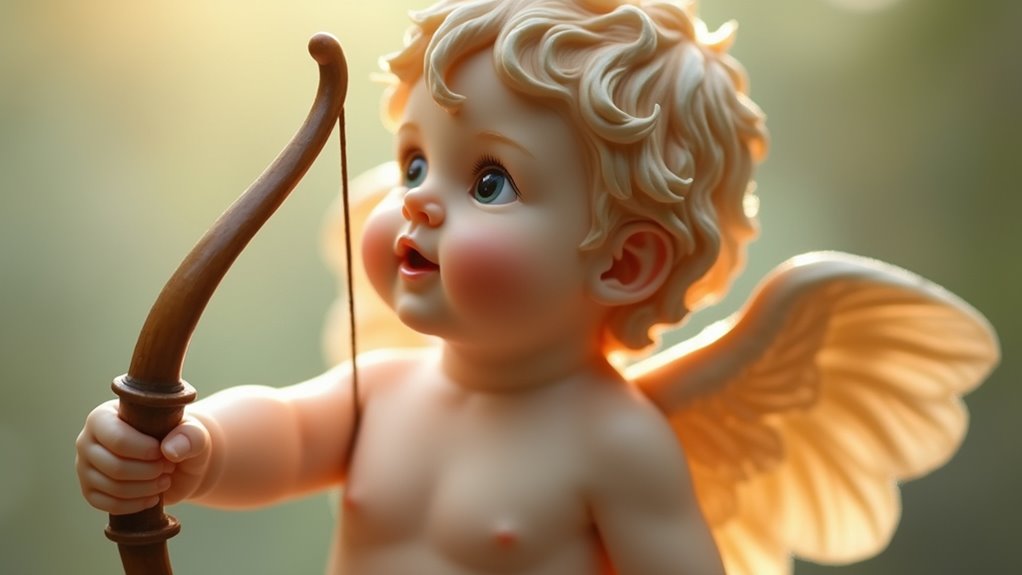Like Eros before him, Cupid wields a bow that symbolizes more than just aim and accuracy. This simple yet powerful image hints at the complex forces behind love itself—its unpredictability, strength, and vulnerability. But why has this small cherub become the universal icon of desire? The story behind Cupid’s bow reveals secrets about love’s divine roots and its enduring influence across cultures, inviting you to explore its deeper meaning.
Key Takeaways
- Cupid’s bow symbolizes divine authority, power, and mastery over love, reflecting his role as a divine matchmaker.
- In mythology, the bow represents love’s precision, unpredictability, and its capacity to strike hearts unexpectedly.
- The bow embodies love’s dual nature—both tender and capable of causing pain, highlighting love’s transformative force.
- Artistic depictions of Cupid’s bow emphasize innocence, divine authority, and the playful or mischievous aspects of love.
- The bow’s symbolism persists culturally, representing romance, passion, and the unpredictable power of love across generations.
The Origins of Cupid in Ancient Mythology
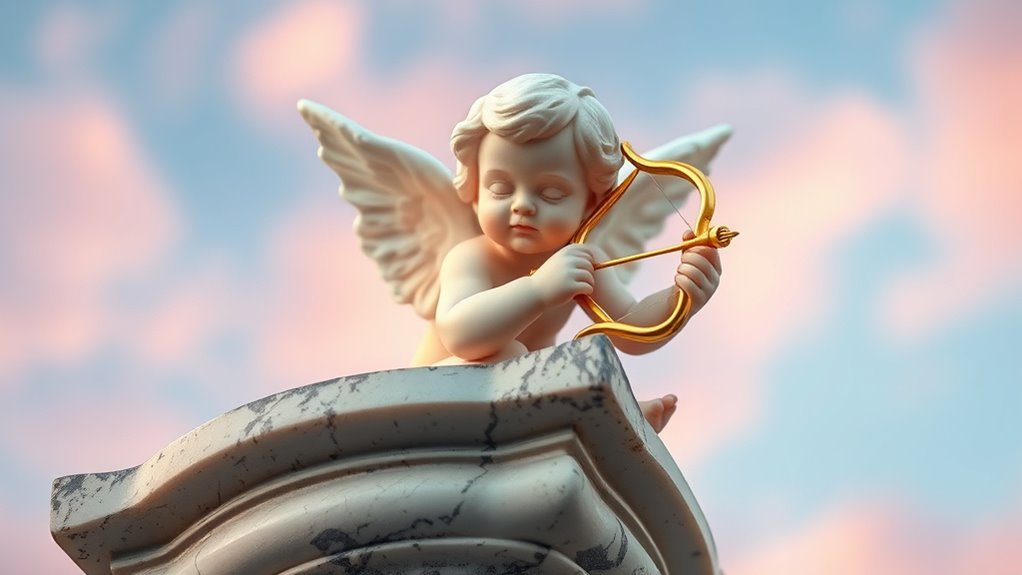
The origins of Cupid in ancient mythology trace back to different cultures, where he was often depicted as a playful, mischievous figure embodying love and desire. His mythical symbolism varies across societies, reflecting unique cultural influences. In Greek mythology, he’s known as Eros, representing passionate love and attraction, often portrayed as a youthful, winged god with a bow and arrow. The Romans adopted and adapted this imagery, emphasizing Cupid’s role as a divine matchmaker. These cultural influences shaped how Cupid became a symbol of love’s unpredictable and playful nature. His mythological roots reveal a universal desire to understand love’s mysteries, blending mythic symbolism with cultural stories that highlight love’s power and complexity across different civilizations.
Cupid’s Connection to Eros and Roman Love Deities
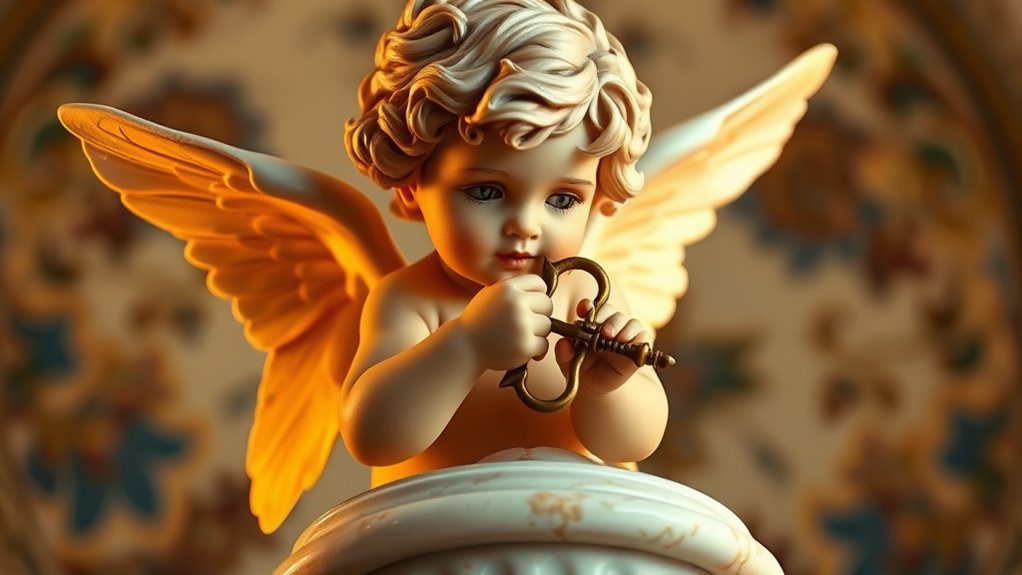
You can see how Cupid’s origins are closely tied to Eros, the Greek god of love, shaping how we view love today. The Roman love deities, influenced by Eros, helped transform Cupid’s image into the playful, mischievous figure we recognize. Exploring these connections reveals how ancient cultures shared and adapted their ideas about love and desire.
Eros: Greek Love God
Eros, the Greek god of love and desire, plays a central role in ancient mythology as the embodiment of passionate attraction. His mythical symbolism represents the powerful, often unpredictable force of love that can strike suddenly and change lives. In Greek culture, Eros is depicted as a youthful winged god wielding a bow and arrows, signifying how love can pierce the heart unexpectedly. Cultural variations reveal different interpretations of Eros’s role; in some stories, he’s playful and mischievous, while in others, he symbolizes the intense, uncontrollable nature of desire. These diverse depictions highlight how ancient societies understood love’s complex and often mysterious influence, shaping their myths and rituals around Eros’s dynamic presence. Additionally, the symbolism of the bow and arrows emphasizes love’s ability to unexpectedly affect individuals, much like modern interpretations of Cupid’s role.
Roman Deities’ Influence
As Roman culture adopted Greek mythology, they integrated and adapted the figure of Eros into their own pantheon, giving rise to Cupid, the Roman god of love. This transformation preserved core love symbolism while emphasizing mythological symbolism unique to Roman traditions. You’ll notice how Cupid’s portrayal aligns with Roman ideals, often depicted as a playful, mischievous figure wielding a bow, symbolizing love’s unpredictability. The connection to Eros highlights shared themes of desire and attraction, yet the Roman version emphasizes love’s role in social and political bonds. By blending Greek influences with their own mythos, Romans reinforced love as a powerful, divine force, making Cupid’s mythological symbolism a timeless representation of love’s complexities across cultures.
The Symbolism of the Bow in Ancient Cultures
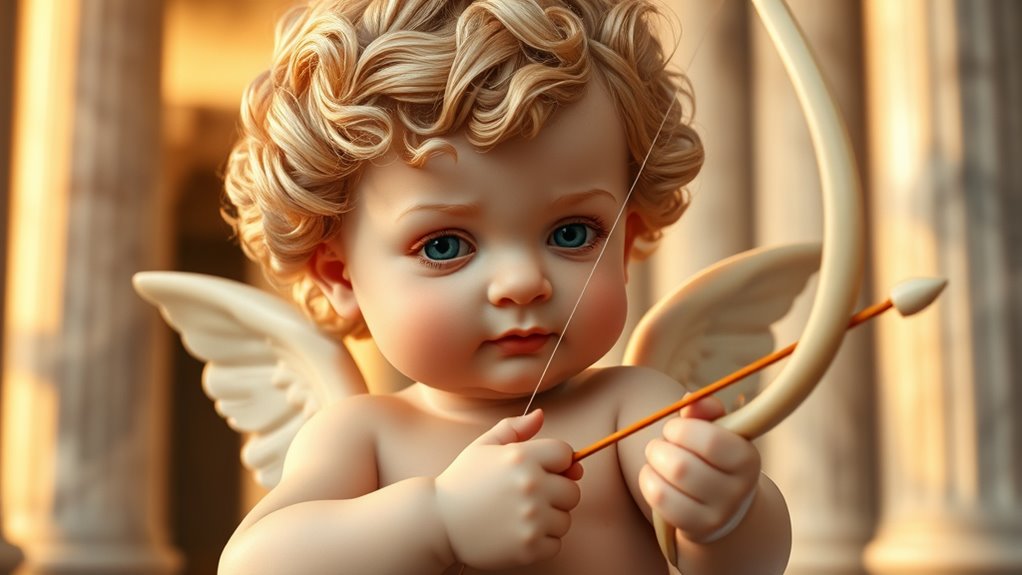
The bow in ancient cultures often symbolizes power and authority, representing the wielder’s strength and control. It also embodies precision and focus, highlighting the importance of aim and intent. Understanding these symbols helps reveal how the bow communicated deeper meanings beyond its practical use. Additionally, the support hours for entertainment venues like SeaWorld or Disneyland reflect the importance of timing and planning, much like the precise aim required when using a bow.
Power and Authority
Throughout ancient cultures, the bow has long symbolized power and authority, representing the ability to exert control and influence over others. Mastery of archery demonstrated your strength and skill, elevating you to a position of respect. In myth, bows often signified divine authority, linking gods and kings to supernatural strength. The mythical symbolism of the bow conveyed your capacity to command armies or protect your dominion. When you wielded a bow, you demonstrated not just physical prowess but also dominance and leadership. This association persisted across civilizations, where the bow became a universal emblem of sovereignty. Its presence in myths and rituals underscored its role as a tool of power—both literal and symbolic—making it a compelling icon of authority throughout history. Additionally, the credibility of gold dealers plays a crucial role in ensuring the integrity of investments, much like the importance of mastery and trust in wielding a bow effectively.
Precision and Focus
Have you ever considered how the bow’s effectiveness depends on exact aim and steady focus? In archery symbolism, precision represents clarity of purpose and deliberate intent. In mythological weaponry, the bow often symbolizes not just power, but also discipline and concentration. Ancient cultures viewed the bow as a tool requiring skillful control, embodying the idea that success hinges on careful aim rather than brute force. When Cupid wields his bow, it highlights that love, like archery, demands focus—targeting the heart with intention. The mythological significance emphasizes that love’s impact depends on precision, reinforcing the importance of focus in both love and life. The bow, thus, becomes a powerful symbol of intentionality and the necessity of clear aim in achieving meaningful connections. Additionally, considering the preppy dog names often reflect a refined sense of style, choosing the right name can symbolize the importance of deliberate choices in life and relationships.
The Myth of Cupid and Psyche
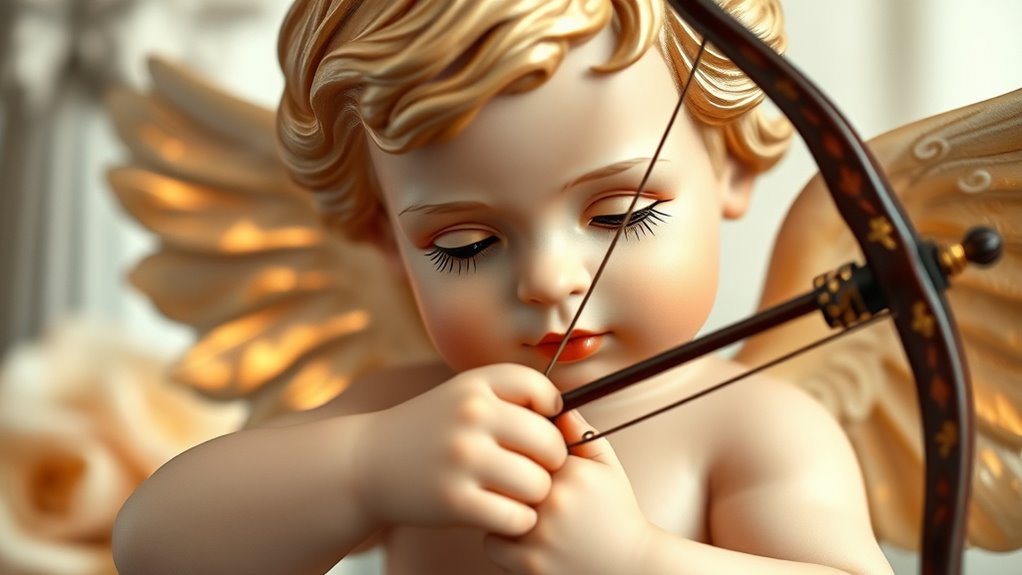
Cupid and Psyche’s story is an enthralling tale of love, jealousy, and redemption that has fascinated people for centuries. You see, love’s symbolism plays a central role here, illustrating love’s power to transform and endure. Cupid, armed with his mythical weapon—a bow—accidentally wounds Psyche with one of his arrows, igniting their forbidden love. Their journey involves overcoming obstacles set by gods and jealous rivals, highlighting the intense emotions involved. Imagine:
- Psyche’s curiosity leading her into danger, symbolizing the trials love requires.
- Cupid’s bow representing both love’s power and the potential for pain.
- The divine interventions that test and ultimately strengthen their bond.
This myth reveals how love can be a divine force, shaped by both desire and divine intervention.
The Role of Cupid’s Bow in Mythical Battles and Love

The bow wielded by Cupid is more than just a weapon; it symbolizes the dual nature of love—its power to unite and its capacity to wound. In mythical battles, Cupid’s bow represents mythical weaponry that can strike hearts instantly, embodying love’s unpredictable force. Culturally, the bow signifies both connection and vulnerability, reflecting how love can heal or hurt. When Cupid fires his arrows, he influences gods and mortals alike, turning affection into a powerful tool of change. This dual symbolism underscores love’s complexity—its ability to bring people together or cause deep pain. By wielding the bow, Cupid personifies love’s strength and fragility, making his weapon a timeless emblem of love’s fierce and tender aspects in mythology. Additionally, the symbolic significance of the bow highlights how love’s impact can be both transformative and delicate, emphasizing its role in shaping relationships across cultures and stories.
Artistic Depictions of Cupid’s Weapon Through the Ages

Throughout history, artists have portrayed Cupid’s bow and arrows in diverse ways, reflecting changing styles and cultural values. In medieval miniature art, his weapon often appears delicate and symbolic, while Renaissance sculptures focus on intricate details and realism. Today, modern pop culture reimagines Cupid’s weapon with bold, playful imagery that resonates with contemporary audiences. The evolution of Cupid’s bow also mirrors the broader trends in art, such as the emphasis on artistic representation and symbolism in different eras.
Medieval Miniature Art
Medieval miniature art vividly captures the delicate balance between innocence and danger in depictions of Cupid’s weapon. These tiny, detailed illustrations reveal how art symbolism was used to convey complex ideas about love and vulnerability. You might see Cupid portrayed with a quiver full of arrows, emphasizing the power of love’s sudden impact. Sometimes, the bow appears ornate, signifying divine authority, while other times, it’s simple, highlighting innocence. The miniature’s vibrant colors and intricate backgrounds enhance the narrative, making Cupid’s weapon both a tool of affection and potential harm. These depictions reflect the medieval mindset—viewing love as a mix of beauty and peril. Additionally, iconography in these miniatures helps viewers interpret the layered meanings behind Cupid’s weapon, reinforcing its dual role as a symbol of both love and danger. Through this art form, you understand how medieval miniature art used visual symbolism to deepen the mythological significance of Cupid’s bow.
Renaissance Sculptures’ Details
Renaissance sculptures bring a new level of realism and detail to depictions of Cupid’s weapon, transforming the myth into a dynamic visual experience. Through renaissance artistry, artists emphasize mythological symbolism by capturing Cupid’s delicate posture and the intricate craftsmanship of his bow. These sculptures highlight fine details, such as the texture of the bowstring, the curvature of the weapon, and Cupid’s expressive face, making his role as a divine archer more vivid. The precise craftsmanship reflects a deeper understanding of myth and an appreciation for human anatomy, elevating Cupid from simple symbol to a complex artistic figure. This era’s sculptures invite you to see Cupid not just as a mythic figure, but as a masterful blend of symbolism and artistry, enriching the myth’s visual storytelling. Additionally, the use of artistic techniques enhances the realism and emotional impact of these sculptures, drawing viewers further into the mythological narrative.
Modern Pop Culture Imagery
Modern pop culture continues to reinterpret Cupid’s weapon, transforming it from classical sculpture into a symbol with new layers of meaning. Today, images of Cupid often appear in cartoons, advertisements, and fashion, where his bow symbolizes love’s power and playfulness. You might see Cupid wielding a bow in a comic strip, representing innocence or mischief, or in a romantic film, embodying desire and passion. These cultural interpretations shift Cupid’s symbolism from ancient ideals to contemporary themes. Additionally, the detailed history of Cupid’s bow reveals its evolution from mythological artifact to modern iconography.
How Cupid’s Bow Represents Love’s Power and Fragility

Cupid’s bow symbolizes both the strength and delicate nature of love. In mythical symbolism, it represents love’s power to inspire passion and unity, yet also highlights its fragility. When you see Cupid draw back his bow, it’s a reminder that love can strike suddenly and intensely, but it’s equally vulnerable to disappointment or heartbreak. The tension in the bow reflects love’s duality—its ability to elevate and devastate. This love symbolism underscores that love isn’t just a force of joy; it’s fragile and must be handled with care. The bow’s tautness signifies the delicate balance between love’s strength and vulnerability, making Cupid’s weapon a fitting emblem of love’s complex, unpredictable nature. Ongoing research into AI vulnerabilities reminds us that even the most trustworthy systems can be exposed to risks, much like love’s unpredictable nature.
Variations of Cupid’s Iconography in Different Cultures
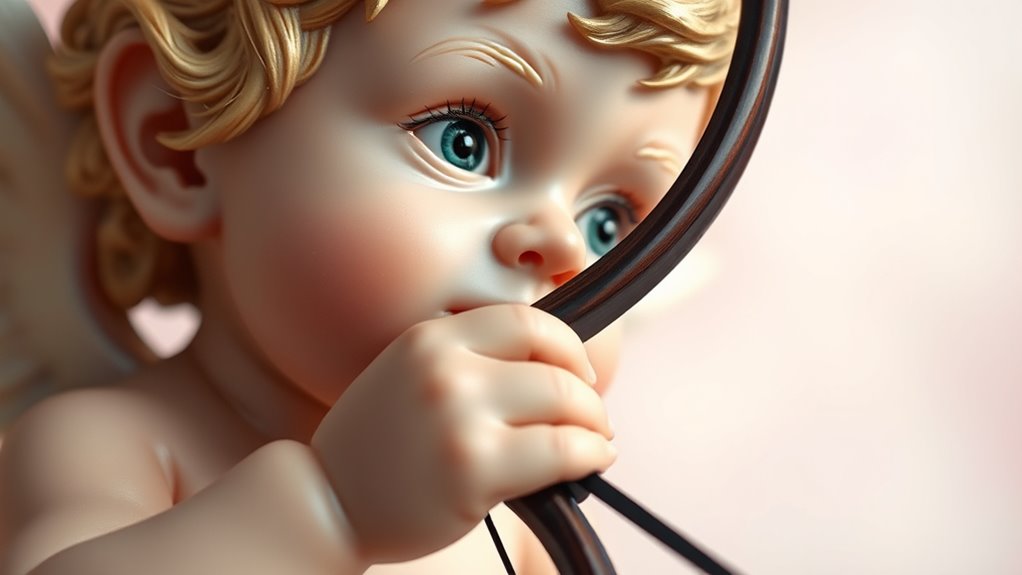
Across different cultures, Cupid’s iconography takes on diverse forms that reflect unique beliefs about love and desire. In some traditions, he’s depicted as a youthful, winged figure wielding a bow, symbolizing love’s playful yet unpredictable nature. In others, mythological motifs feature him as a chubby, cherubic child, emphasizing innocence and affection. Cultural symbolism influences these variations, blending local beliefs with mythic themes. For example:
- In Roman mythology, Cupid appears as a mischievous boy with wings, embodying love’s spontaneous power.
- In Hindu culture, Kamadeva resembles a handsome god armed with a sugarcane bow, representing desire’s divine aspect.
- In Chinese folklore, love gods like Yue Lao are often shown as wise elders, highlighting wisdom in love’s pursuit.
These variations showcase how mythological motifs adapt to different cultural contexts, enriching Cupid’s universal symbolism.
The Evolution of Cupid’s Image in Modern Art and Media

How has Cupid’s image transformed through art and media over time? You’ve likely seen him as a playful, winged child, symbolizing love and innocence. Modern art and media have shifted his portrayal, blending traditional love symbolism with contemporary cultural interpretations. In paintings, Cupid is often depicted as mischievous or romantic, emphasizing love’s complexity. Films and advertisements sometimes portray him as a humorous or satirical figure, reflecting changing attitudes toward love and desire. These adaptations reveal how cultural interpretations influence his image, moving beyond the classical cherub to embody diverse emotions and ideas about romance. As a result, Cupid remains a powerful symbol of love, continually evolving to mirror society’s evolving attitudes and artistic expressions.
The Enduring Symbolism of Cupid’s Bow in Contemporary Culture
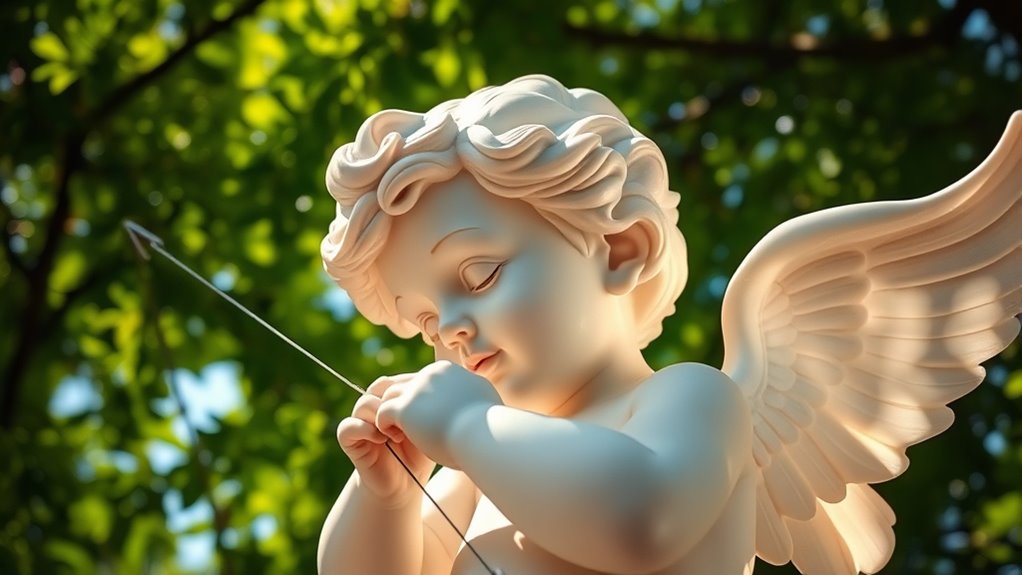
The bow, as a central symbol of Cupid, continues to represent love’s power and precision in contemporary culture. Its historical symbolism persists, reminding us of love’s ability to strike unexpectedly and accurately. You might see Cupid’s bow in modern art, fashion, or branding, symbolizing romance and emotional connection. Its cultural influence is evident in popular media, from movies to advertising, where it evokes themes of affection and vulnerability.
- Modern tattoos depicting Cupid’s bow symbolize devotion and passion
- Valentine’s Day imagery often features the bow as a symbol of love’s target
- Fashion brands incorporate the bow to evoke timeless romance and charm
This enduring symbol reminds us that love’s influence remains powerful and precise across generations.
Frequently Asked Questions
Why Is Cupid Depicted With a Bow Instead of Other Weapons?
You might wonder why Cupid is depicted with a bow instead of other weapons. In mythological symbolism, the bow represents love’s power to strike unexpectedly and precisely. Its choice as a weapon highlights Cupid’s role in targeting hearts with accuracy and force, emphasizing love’s sudden, often uncontrollable nature. The bow’s association with both hunting and affection makes it the perfect symbol for Cupid’s role in inspiring love and desire.
How Does Cupid’S Bow Symbolize Both Love and Conflict?
Imagine a delicate string tugging at your heart, embodying the dichotomy of desire and conflict. Cupid’s bow symbolizes this tension through its dual role: it’s a symbolic representation of love’s sweetness and pain. When he aims, love ignites, but the arrow’s sharp point also hints at the potential for heartbreak and struggle. This allegory captures how love can be both enchanting and tumultuous, all in one elegant weapon.
Are There Cultural Differences in Cupid’S Depiction With a Bow?
You’ll notice that ancient depictions of Cupid often show him with a bow, but cultural variations exist. In Greek mythology, he’s sometimes shown with a more elaborate or symbolic bow, while in Roman art, the focus is on the playful, mischievous nature. Different cultures emphasize various aspects of Cupid’s character through his depiction, highlighting unique interpretations of love, desire, and conflict across civilizations.
What Is the Significance of Cupid’S Bow in Modern Storytelling?
Think of Cupid’s bow as a symbol of love’s power, a mythical symbolism that strikes hearts with a gentle yet decisive force. In modern storytelling, it represents love’s unpredictability and the idea that feelings can be both tender and impactful. Cultural variations influence its portrayal, but the core message remains: love is a divine force that can inspire, transform, and challenge you, just like a bow that both releases and sustains.
How Has Cupid’S Symbolism Influenced Contemporary Romantic Practices?
You see, Cupid’s symbolism influences modern romantic practices by embodying love’s playful yet powerful nature. As artificial intelligence advances, it often incorporates romantic symbolism like Cupid’s bow to evoke emotional connections. This blend of myth and tech encourages you to see love as both timeless and innovative, inspiring gestures from virtual dating to personalized gifts. Cupid’s image continues to remind you that love’s essence remains rooted in passion, playfulness, and connection.
Conclusion
Just like a master archer, Cupid’s bow symbolizes your ability to influence love’s course with precision and power. Its timeless presence reminds you that love is both a delicate target and a force to be reckoned with. As you navigate relationships, remember that love’s strength lies in its unpredictability—much like Cupid’s arrows, striking when you least expect. Embrace the bow’s symbolism, and let love’s mystery guide your heart’s aim.
